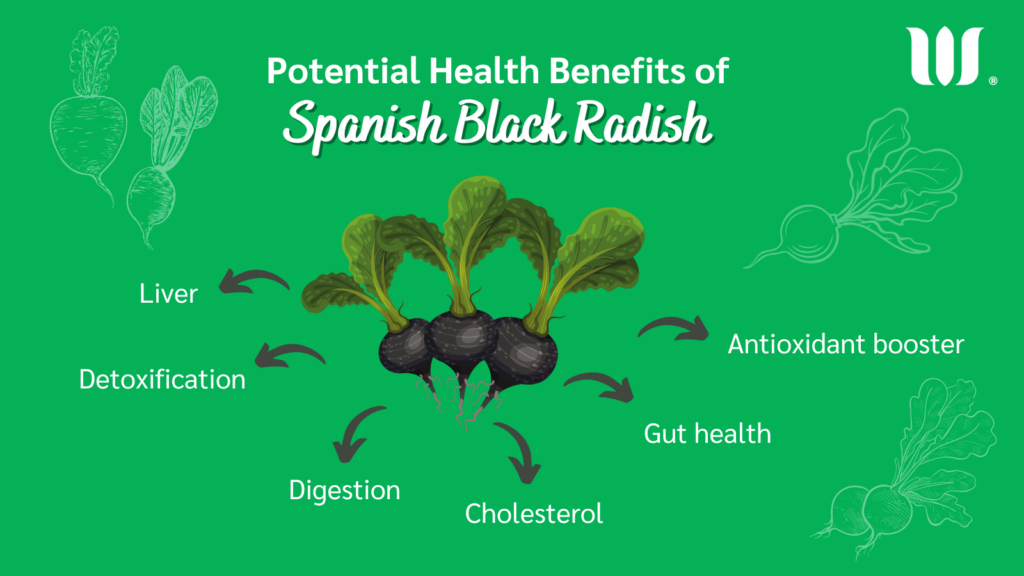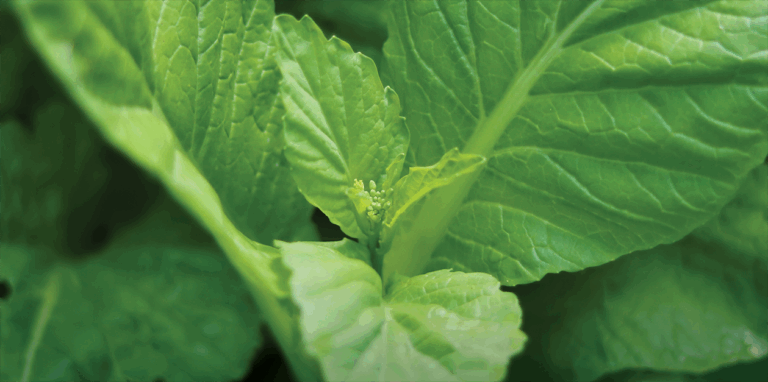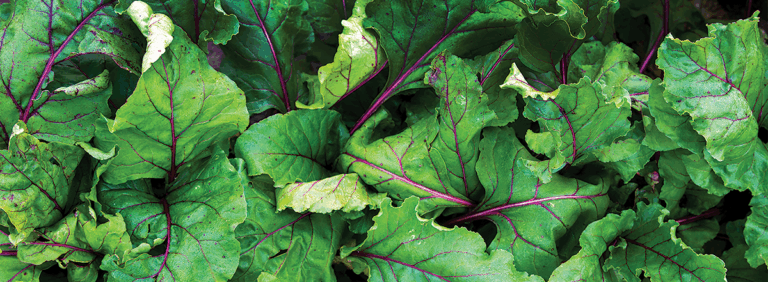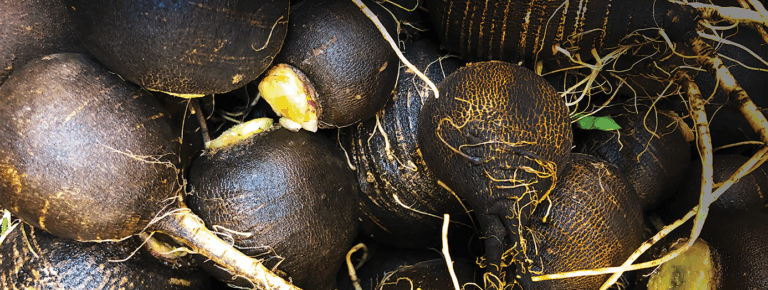Spanish Black Radish: What is Old is New Again
Spanish black radish, or Raphanus sativus niger, is a large root vegetable that belongs to the Brassicaceae family, also known as the cruciferous vegetable family. It’s a type of winter radish related to broccoli, cabbage, kale, and horseradish. In fact, it is often called Parisian horseradish due to its unique and pungent flavor.
This distinctive radish is much larger than other varieties of radishes, and it is believed to have first been cultivated in the eastern portion of the Mediterranean, spreading throughout Europe during the Middle Ages. By the 1500s, Spanish black radish became the most commonly grown radish in Europe, likely due to its hardy nature and being so easily grown. In fact, the Greek word for radish means “easily reared.”1
Just as the history of this radish is long and storied, so is the medicinal use of black radishes. Based on ancient Egyptian drawings, it is believed that the ancient Egyptians considered black radishes to be sacred and used them as medicine.
In Ayurvedic tradition, various radishes are used therapeutically, but black radishes are considered stronger. They are used for digestion, to detoxify the liver and gallbladder, and to boost the immune system – many of the same reasons Spanish black radish is recommended today.2
Phytoactive Nutrients
Spanish black radish is known for its unusually high levels of a phytonutrient called glucosinolate that makes it useful as a healing food, particularly for healthy digestion and liver and gallbladder support. Spanish black radish contains four times the amount of glucosinolates found in other common cruciferous vegetables, making it especially impactful to health and disease prevention.3 Interestingly, glucosinolates are responsible for the distinctive scent of cruciferous vegetables, including radishes.
Glucosinolates are biologically active, sulfur-containing glucosides abundant in cruciferous plants. Cutting, chopping, or even the act of chewing glucosinolate-rich foods releases myrosinase enzymes, which hydrolyze glucosinolate into its metabolites.
When those same foods are cooked before eating, myrosinase is deactivated, and glucosinolates are absorbed intact and hydrolyzed into their metabolites by intestinal microbes. Glucosinolate metabolites include indole-3-carbinols, isothiocyanates, and sulforaphane: phytonutrients shown to increase the production of detoxification enzymes and linked with lower rates of certain cancers.4 Regardless of whether glucosinolate-rich foods are eaten raw or cooked, the benefits of these phytonutrient metabolites are still imparted.
Powerful Metabolites
Glucosinolate metabolites have been linked with reduced risk for certain cancers in population studies. This may be due to several different cancer-killing mechanisms that are still being explored, including inducing programmed cell death, a process called apoptosis, increasing the biotransformation of environmental toxins, reducing oxidative stress, inhibiting angiogenesis, and modulating cell cycle arrest.5
Spanish black radishes are particularly high in glucoraphasatin, the predominant type of glucosinolate found in radishes. In fact, this phytonutrient is only found in radishes and not in any other brassica.6 One glucoraphasatin metabolite, raphasatin, has been found to upregulate the expression of phase I and II detoxification enzymes.7 Spanish black radish as a whole food has been found to induce both phase I and II detoxification enzymes, as well as stimulate glutathione s-transferase, and CYP enzymes.7 These cellular activities may be responsible for the wide range of important potential health benefits Spanish black radish offers.
Spanish Black Radish’s Potential Health Benefits
A growing body of research has lent strong support to what the ancients seemed to know all along – Spanish black radish can be a powerful medicinal food, especially when it comes to digestion and detoxification.

Liver and detoxification support
Spanish black radish and supplements made from it have been found to be liver protective and to help the body eliminate toxins more efficiently. In human studies, it’s been found to upregulate both phase I and II detoxification enzymes, as well as enhance the clearance of acetaminophen.7
It is important for a liver supportive compound to support both phases of detoxification, because phase I detoxification results in the formation of unstable intermediary molecules that can trigger free radical damage and oxidative stress if phase II is not also upregulated. Antioxidant activity and stimulating phase II detoxification protects against those intermediate molecules, ensuring a balance between the two phases and improved elimination of toxins.
Another way Spanish black radish may protect hepatic function and liver health is with regard to non-alcoholic fatty liver disease. Research has found that it may be protective to healthy liver function and may mitigate many causes of non-alcoholic fatty liver disease.8
Digestion and cholesterol support
Spanish black radish stimulates bile function, which supports digestion and may also support healthy cholesterol levels.9 In animal studies, Spanish black radish juice has been shown to decrease cholesterol levels and dissolve gallstones. Some research has suggested that its cholesterol reducing activity may also prevent the formation of cholesterol gallstones.10 In fact, traditional Mexican medicine uses Spanish black radish as a remedy for gallstones.
Gut health
As a rich source of phytonutrients, Spanish black radish supports gut health through several mechanisms. The antioxidants and anti-inflammatory phytonutrients found in Spanish black radish help balance the redox state of intestinal cells which also helps contribute to healthy inflammation in the gut.(11) Brassicaceae vegetables including Spanish black radish also demonstrate the ability to help maintain the integrity of the gut barrier and positive modulate gut microbial communities, contributing to a healthy gut microbiome.(12,13)
Antioxidant booster
In addition to balancing phase I and II detoxification enzymes and offering protection against toxic intermediary metabolites, Spanish black radish has also been found to protect the liver from oxidative damage in animals, and it significantly upregulates an enzyme system called Nrf2, or nuclear factor erythroid 2-related factor 2.11 Nrf2 is a transcription factor that codes for endogenous antioxidant production. Upregulating Nrf2 increases the amount of endogenous antioxidant proteins our bodies make, which offers protection against oxidative damage.
When to Recommend Spanish Black Radish
With so many potential benefits, Spanish black radish can be an important instrument in any practitioner’s toolbox. Practitioners may consider using Spanish black radish for:
- Gallbladder drainage
- Liver support
- Detoxification support
- As a dietary or food-based supplemental source of indole-3-carbinol
Download the Spanish black radish pamphlet from the Color of Food series.
- Wightman, T. (2017) Forgotten vegetables: The black radish. Instants. https://www.relaischateaux.com/us/magazine/taste-of/savour/forgotten-vegetables-the-black-radish?_locale=de
- Khalsa, K., & Tierra, M. (2008). The way of Ayurvedic herbs:The most complete guide to natural healing and health with traditional Ayurvedic herbalism. Lotus Press.
- N’jai, A.U., Kemp, M.Q., Metzger, B.T., et. al. (2012). Spanish black radish (Raphanus sativus L. Var. niger) diet enhances clearance of DMBA and diminishes toxic effects on bone marrow progenitor cells. Nutr Cancer, 64(7):1038-48. doi: 10.1080/01635581.2012.714831.
- Barba, F.J., Nikmaram, N., Roohinejad, S., et al. (2016). Bioavailability of glucosinolates and their breakdown products: Impact of processing. Front Nutr, 3:24. doi: 10.3389/fnut.2016.00024. eCollection 2016.
- Arumugam, A., & Abdull Razis, A.F. (2018). Apoptosis as a mechanism of the cancer chemopreventive activity of glucosinolates: a review. Asian Pac J Cancer Prev, 19(6):1439‐1448. doi:10.22034/APJCP.2018.19.6.1439
- Kakizaki, T., Kitashiba, H., Zou, Z., et al. (2017). A 2-oxoglutarate-dependent dioxygenase mediates the biosynthesis of glucoraphasatin in radish. Plant Physiol, 173(3):1583‐1593. doi:10.1104/pp.16.01814
- Evans, M., Paterson, E., & Barnes, D.M. (2014). An open label pilot study to evaluate the efficacy of Spanish black radish on the induction of phase I and phase II enzymes in healthy male subjects. BMC Complement Altern Med, 14:475. doi:10.1186/1472-6882-14-475
- Ahn, M., Kim, J., Choi, Y., et al. (2019). Fermented black radish (Raphanus sativus L. var. niger) attenuates methionine and choline deficient diet-induced nonalcoholic fatty liver disease in mice. Food Sci Nutr, 7(10):3327‐3337. Published 2019 Sep 9. doi:10.1002/fsn3.1200
- Lugasi, A., Blázovics, A., Hagymási, K., Kocsis, I. and Kéry, Á. (2005), Antioxidant effect of squeezed juice from black radish (Raphanus sativus L. var niger) in alimentary hyperlipidaemia in rats. Phytother. Res., 19: 587-591. doi:10.1002/ptr.1655
- Castro‐Torres, I.G., De la O‐Arciniega, M., Gallegos‐Estudillo, J., Naranjo‐Rodríguez, E.B., & Domínguez‐Ortíz, M.Á. (2014), Raphanus sativus L. var niger as a source of phytochemicals for the prevention of cholesterol gallstones. Phytother. Res., 28: 167-171. doi:10.1002/ptr.4964
- Ahn, M., Kim, J., Hong, J., Kim, J., Ko, H., Lee, N.H., Kim, G.O., & Taekyun, S. (2019). Journal of Medicinal Food, 866-875. http://doi.org/10.1089/jmf.2017.4102







